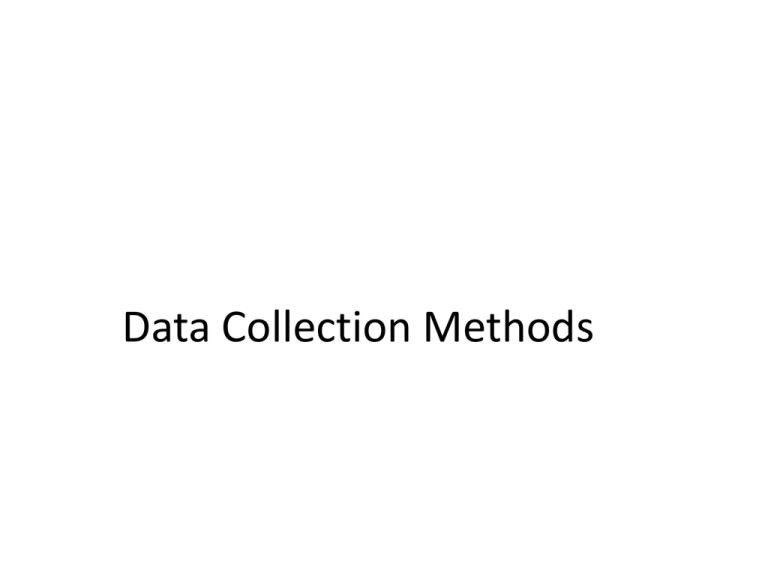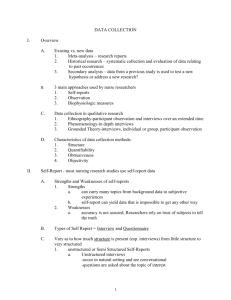Data Collection Methods
advertisement

Data Collection Methods Data Collection Plan Basic decision is use of: • New data, collected specifically for research purposes, or • Existing data – Records (e.g., patient charts) – Historical data – Existing data set (secondary analysis) Examples of Records, Documents, and Available Data • • • • • Hospital records (e.g., nurses’ shift reports) School records (e.g., student absenteeism) Corporate records (e.g., health insurance choices) Letters, diaries, minutes of meetings, etc. Photographs Major Types of Data Collection Methods • Self-reports • Observation • Biophysiologic measures Dimensions of Data Collection Approaches • • • • Structure Quantifiability Researcher obtrusiveness Objectivity Types of Qualitative Self-Reports • Unstructured interviews – Conversational, totally flexible – Use of grand tour questions • Semistructured interviews – Use of a topic guide Types of Qualitative Self-Reports (cont.) • Focus group interviews – Interviews in small groups (5 to 10 people) – Led by a moderator • Life histories – Narrative self-descriptions of life experiences – Often a chronology Types of Qualitative Self-Reports (cont.) • Critical incidents interviews – Focuses on specific incidents that had a discernible impact on some outcome • Think-aloud method – Means of collecting data about cognitive processes as they unfold (e.g., clinical decisionmaking) • Diaries and journals Question Is the following statement True or False? • A focus group typically involves at least 10 to 15 people. • False Answer – A focus group usually involves interviews with small groups, ranging in size from 5 to 10 people. Structured Self-Reports • Data are collected with a formal instrument. – Interview schedule • Questions are prespecified but asked orally. • Either face-to-face or by telephone – Questionnaire • Questions prespecified in written form, to be selfadministered by respondents Types of Questions in a Structured Instrument • Closed-ended (fixed alternative) questions – e.g., “Within the past 6 months, were you ever a member of a fitness center or gym?” (yes/no) • Open-ended questions – e.g., “Why did you decide to join a fitness center or gym?” Specific Types of Closed-Ended Questions • • • • • • Dichotomous questions Multiple-choice questions Cafeteria questions Rank-order questions Forced-choice questions Rating questions Advantages of Questionnaires (Compared with Interviews) • Lower costs • Possibility of anonymity, greater privacy • Lack of interviewer bias Advantages of Interviews (Compared with Questionnaires) • Higher response rates • Appropriate for more diverse audiences • Opportunities to clarify questions or to determine comprehension • Opportunity to collect supplementary data through observation Question Which of the following would be an advantage of using a questionnaire? a. Higher response rates b. Diversity of audience is not a problem. c. Less potential for interviewer bias d. Questions can be clarified if needed. Answer c. Less potential for interviewer bias • When a questionnaire is used, there is lack of interviewer bias along with greater privacy and possible anonymity. Higher response rates are obtained with interviews. Interviews also are appropriate for more diverse audiences and provide opportunities to clarify questions or determine comprehension. Composite Psychosocial Scales • Scales—used to make fine quantitative discriminations among people with different attitudes, perceptions, traits • Likert scales—summated rating scales • Semantic differential scales Likert Scales • Consist of several declarative statements (items) expressing viewpoints • Responses are on an agree/disagree continuum (usually 5 or 7 response options). • Responses to items are summed to compute a total scale score. Semantic Differential Scales • Require ratings of various concepts • Rating scales involve bipolar adjective pairs, with 7point ratings. • Ratings for each dimension are summed to compute a total score for each concept. Example of a Semantic Differential Visual Analog Scale (VAS) • Used to measure subjective experiences (e.g., pain, nausea) • Measurements are on a straight line measuring 100 mm • End points labeled as extreme limits of sensation Response Set Biases • Biases reflecting the tendency of some people to respond to items in characteristic ways, independently of item content • Examples: – Social desirability response set bias – Extreme response set – Acquiescence response set (yea- sayers) – Nay-sayers response set Question Is the following statement True or False? • A Likert scale would be appropriate for measuring a person’s pain. • False Answer – A visual analog scale would be more appropriate to use when measuring a person’s pain. Q Sorts • Participants sort a deck of cards into piles according to specific criteria. • Cards contain statements to be sorted on a bipolar continuum (e.g., most like me/least like me). • Usually 50 to 100 cards; usually 9 or 11 piles Vignettes • Brief descriptions of situations to which respondents are asked to react • Descriptions are usually written “stories.” • Respondents can be asked open-ended or closedended questions about their reactions. • Aspects of the vignettes can be experimentally manipulated. Evaluation of Self-Reports • Strong on directness • Allows access to information otherwise not available to researchers • But can we be sure participants actually feel or act the way they say they do? Phenomena Amenable to Research Observation • Activities and behavior • Characteristics and conditions of individuals • Skill attainment and performance • Verbal and nonverbal communication • Environmental characteristics Observation in Qualitative and Quantitative Studies • Qualitative studies: Unstructured observation in naturalistic settings – Includes Participant observation • Quantitative studies: Structured observation of prespecified behaviors The Observer–Participant Role in Participant Observation • Leininger’s Four-Phase Sequence: – Primarily observation – Primarily observation with some participation – Primarily participation with some observation – Reflective observation Question Is the following statement True or False? • In qualitative studies, observation is unstructured. • True Answer – Observation with a qualitative study is unstructured and occurs in naturalistic settings. Recording Unstructured Observations • Logs (field diaries) • Field notes – Descriptive (observational) notes – Reflective notes: • Methodologic notes • Theoretical notes (or analytical notes) • Personal notes Structured Observations • Category systems Checklists – Formal systems for systematically recording the incidence or frequency of prespecified behaviors or events – Systems vary in their exhaustiveness • Exhaustive system: All behaviors of a specific type recorded, and each behavior is assigned to one mutually exclusive category • Nonexhaustive system: Specific behaviors, but not all behaviors, recorded Observational Rating Scales • Ratings are on a descriptive continuum, typically bipolar • Ratings can occur: – at specific intervals – upon the occurrence of certain events – after an observational session (global ratings) Observational Sampling • Time-sampling—sampling of time intervals for observation Examples: • Random sampling of intervals of a given length • Systematic sampling of intervals of a given length • Event sampling—observation of integral events Evaluation of Observational Methods • Excellent method for capturing many clinical phenomena and behaviors • Potential problem of reactivity when people are aware that they are being observed • Risk of observational biases—factors that can interfere with objective observation Biophysiologic Measures • In vivo measurements – Performed directly within or on living organisms (e.g., blood pressure measures) • In vitro measurements – Performed outside the organism’s body (e.g., urinalysis) Question Which of the following would be classified as an in vivo biophysiologic measure? a. Tissue biopsy b. Blood glucose level c. Bacterial culture d. Body temperature d. Body temperature Answer – In vivo measures are those performed directly within or on living organisms, such as blood pressure, body temperature, and vital capacity measurement. Tissue biopsy, blood glucose level, and bacterial culture are examples of in vitro measures. Evaluation of Biophysiologic Measures • Strong on accuracy, objectivity, validity, and precision • May be cost-effective for nurse researchers • But caution may be required for their use, and advanced skills may be needed for interpretation.










